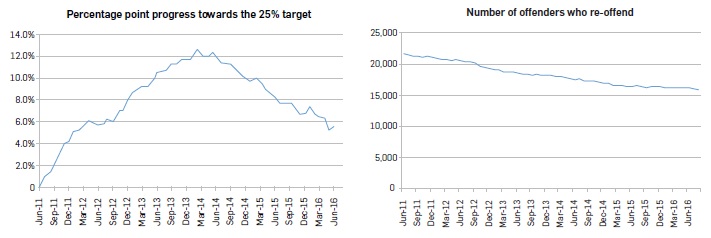Appendix One: Progress towards the June 2017 target of a 25% reduction in re-offending
Background
Corrections’ Better Public Services (BPS) re-offending measure is a composite of the reconviction rate for offenders serving community-based sentences and the reimprisonment rate of prisoners.
Analysis conducted since the target was set in 2012 shows that the overall rate of re-offending fell between June 2011 and February 2014, at which point Corrections was just over half-way towards the 25% reduction target.
Since February 2014, the rate of reduction has flattened off, and from mid 2014 it has been increasing slowly. The current rate is still well below the June 2011 rate, and reached a peak of 7.8% in this financial year.

Analysis
The stall in progress towards the 25% reduction target is at odds with Corrections’ positive results in offender rehabilitation outcomes. These results have been improving year-on-year, with significant reductions in reconvictions and reimprisonment now being consistently recorded for most of our key rehabilitation programmes. In addition, the proportion of the offender population who are successfully engaged in rehabilitation programmes has never been as high as in the last three years. This has increased further since the beginning of 2015, following implementation of the RR25% Boost initiative.
The lack of reflection of these results in Recidivism Index (RI) figures implicates other factors, outside of Corrections’ control, in the current trend. Analysis undertaken within the Department, as well as by the Ministry of Justice1, has identified a number of factors that appear, either singly or in combination, to have contributed to the recent upturn in the RI rate. The factors identified are the rates of prosecution and conviction, the types of sentences imposed and court disposal times.
Further, a falling number of new sentence starts with Corrections in recent years has brought about a change in the composition of the offender population under management. This now features a greater proportion of recidivistic offenders, more of whom have gang connections, and fewer first-time offenders. This change in mix has had a direct and adverse impact on the annual re-offending rate.
Current responses
Corrections is continuing to roll out elements of the Boost initiative, and is improving the quality of existing rehabilitation and reintegration programmes.
Note on progress
It is important to note that the number of offenders who re-offend has been declining over the past five years, with almost 25% fewer re-offenders in the system than in 2011. As shown in the graph on the previous page, this decline in re-offending has occurred consistently since the setting of our BPS target. This shows that significant, positive progress has been made, although this has not been captured within the precise terms and measurements that apply to our BPS target.
Conclusion
On the basis of recent results, it is unlikely that the target of 25% reduction in the rate of re-offending by 2017 will be achieved. Analysis indicates that the measure is susceptible to a range of external influences, which unfortunately obscure the positive impacts of offender rehabilitation and reintegration. Corrections continues to ramp up efforts to ensure that the most effective rehabilitation services are delivered as widely as possible to the offenders that we manage.
1 "Drivers of the BPS reconviction rate measure other than re-offending" (August 2015). Ministry of Justice Forecasting and Modelling Team.

